
| Daihatsu |
| Hino
(truck) - 50.1% |
| Subaru -
16.5% |
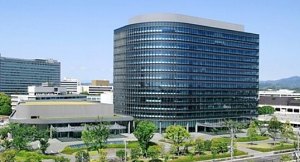 Headquarters:
Toyota City,
Aichi.
Headquarters:
Toyota City,
Aichi.Assembly plants in Japan: mostly in Toyota City
Overseas main plants:
- Australia: Camry
- Canada: Corolla, Matrix, RX, Rav4
- Tianjin, China (JV with FAW): Vios, Corolla, Crown, Reiz, Rav4
- Guangzhou, China: Camry, Yaris, Highlander
- Czech (JV with PSA): Aygo
- France: Yaris
- India: Corolla, Etios
- South Africa: Corolla, Hilux
- Kuozui, Taiwan: Corolla, Camry, Yaris, Vios, Wish
- Thailand: Corolla, Camry, Vios, Yaris, Prius, Hilux
- Turkey: Corolla, Verso
- Burnaston, UK: Auris, Avensis
- Kentucky, USA: Camry, Avalon
- Indiana, USA: Highlander, Sequoia, Sienna
- Texas, USA: Tundra, Tacoma
- Mississippi, USA: Corolla
Main R&D centers: Toyota City (head office), Higashi-Fuji, Ann Arbor (Michigan, USA)
Main proving grounds: Shibetsu City
Main design studios: Tokyo, Nice (France), Calty (California, USA)
FY2017/18: 10,441,000 units
FY2016/17: 10,251,000 units
FY2015/16: 10,094,000 units
FY2014/15: 10,168,000 units
FY2013/14: 10,133,000 units
FY2012/13: 9,692,000 units
FY2011/12: 8,334,000 units
FY2010/11: 8,423,000 units
FY2009/10: 8,139,000 units
FY2008/09: 8,327,000 units
FY2007/08: 9,430,000 units
FY2006/07: 9,005,000 units
FY2005/06: 8,252,000 units
FY2004/05: 7,637,000 units
FY2003/04: 7,016,000 units
FY2002/03: 6,360,000 units
FY2001/02: 5,909,000 units
FY2000/01: 5,817,000 units
FY2017/18 sales by division:
Toyota: approx. 9,210,373 units (including Lexus)
Daihatsu: 1,043,684 units
Hino: 186,943 units
Lexus global sales:
CY2019: 765,330 units
CY2018: 698,330 units
CY2017: 637,000 units
CY2016: 677,615 units
CY2015: 652,000 units
CY2014: 582,000 units
CY2013: 523,000 units
CY2012: 476,566 units
CY2011: 404,000 units
CY2007: 518,300 units
Reference:
http://www.toyota-global.com/investors/financial_result/
https://www.daihatsu.com/news/index.html
http://www.hino-global.com/for_investors/financial_results/index.html
Toyota is a typical example of how Japanese industry succeeded. Although it is often conservative in design and not very creative in bringing new ideas, its special attention to build quality and reliability wins customer confidence gradually. Its emphasis on technology development and production efficiency results in up-to-date products and good value for money. That's why its cars capture a lot of brains if not hearts. Nevertheless, in recent years Toyota starts getting more creative no matter in design and technology. Examples are Pruis and iQ. Hopefully it will be even stronger in the future.
Toyota does not have many brands and subsidiaries. Most cars are sold under its own brand, while Daihatsu takes care of mini cars (especially Kei-cars) and Lexus concentrates on premium and luxury cars. Scion is a youthful brand created by its US marketing division and is still rather insignificant. Heavy trucks and commercial vehicles are produced by its subsidiary Hino. Toyota did not invest into foreign marques, as it believes more in its own effort.
Toyota struggled during the wartime. After the war, its damaged factory was rebuilt, but now the whole country was facing difficult economy. Materials were scarce and inflation was sky rocketing. The company nearly bankrupted in 1950. Eventually Kiichiro Toyoda resigned and 25 percent workers were dismissed.
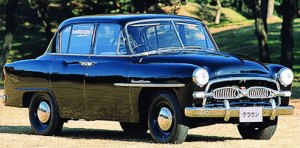 1955 Toyota Crown
1955 Toyota CrownEiji Toyoda, the cousin of Kiichiro, took over the managing post of the company. Under his leadership, Toyota improved its production system upon American system. The so-called "Toyota Production System" encouraged workers at every stage to suggest for improvement. Faults are fixed at each stage to prevent from costly rework at the final quality check. This improved quality as well as overall efficiency. Besides, the Toyota system introduced "just-in-time" parts delivery to the supply chain so to eliminate the need of large warehouses for storing completed parts. This saved costs and reduced risks of over supply.
Apart from production process, Toyota also devoted high percentage of its earnings into the latest production equipment in order to raise efficiency. In the product side, it concentrated on developing small and medium cars in order to avoid direct competition with the dominating American large cars. These works paid off in the late 1950s when Japanese economy took off. From 1955 to 1965, Toyota's output rocketed from 8,400 to 600,000 cars ! During this period, notable models include the 1955 Crown (first car developed entirely by itself), the 1964 Corona (first successful export to USA) and the 1966 Corolla (Toyota's best seller in Japan and worldwide). Like other Japanese cars, Toyota cars were renowned for good value for money, offering competitive performance and features at lower prices than their Western rivals. Their frequent updates - around 4 years each generation - kept them fresh in the eyes of consumers.
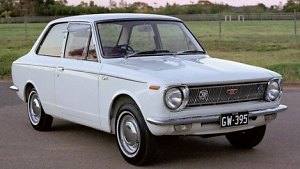 1966 Toyota Corolla
1966 Toyota CorollaThe business of Toyota was increasingly driven by export, especially to the USA market. Oil crisis did not hurt it, but actually drove more customers to its small cars. In 1972, its annual production exceeded 1 million units for the first time. Just 4 years later, it surpassed the 2-million mark. By 1980, Japan overtook USA as the biggest car production country in the world. Toyota accounted for about 40 percent of the Japanese production.
The domestic factories in Toyota City reached their peak in 1990, with over 4 million cars produced that year. However, this export-driven economy cannot last forever. Protectionism rose in the United States as well as in Europe. Toyota relieved such pressure by moving the production of its Camry to USA and Carina to UK so that local people would feel comfortable with these cars. Production localization also allowed it to tailor-make its cars to suit the taste of different markets. In addition to its superior quality control and fuel economy, no wonder Camry could become America's best selling car since 1997, beating its Detroit rivals in their home soil !
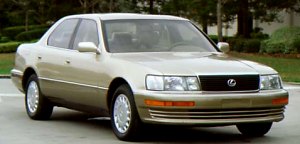 1989 Lexus LS400
1989 Lexus LS400Another problem Toyota faced from the late 1980s was the rising yen and labour costs which made its cars less bargain, especially against Korean cars. The Japanese giant dealt with this problem by moving production overseas on the one hand (while retaining the high-value R&D works in Japan) and moving its cars upmarket on the other hand. It started invading high-end segment with Lexus LS400. It also produced a trio of sports coupes - MR2, Celica and Supra - to boost its image. In this way, the comany reached its first peak in the early 1990s.
However, following the burst of "bubble economy", Japan went into a decade-long recession. Inevitably, Toyota had its domestic sales suffered, but fortunately its overseas business continued growing. Entering 2000s, it resumed rapid growth and overtook General Motors as the world's best selling car maker in 2007 (although in terms of profitability it had been the world's No. 1 much earlier).
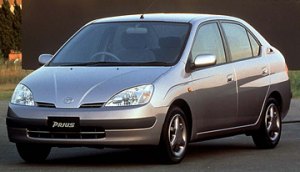 1997 Toyota Prius
1997 Toyota PriusToyota's cars were usually criticized as conservative and lack of innovations compared with local rival Honda. In recent years there seemed to be some changes. In 1997 it introduced the world's first production electric-petrol hybrid technology into Prius. This was followed by the funky designs of WiLL series and bB, the innovative packaging of Yaris and iQ and the sophisticated styling theme ("L-finesse") of Lexus. Its unrivaled financial strength allowed it to explore areas no rivals could afford.